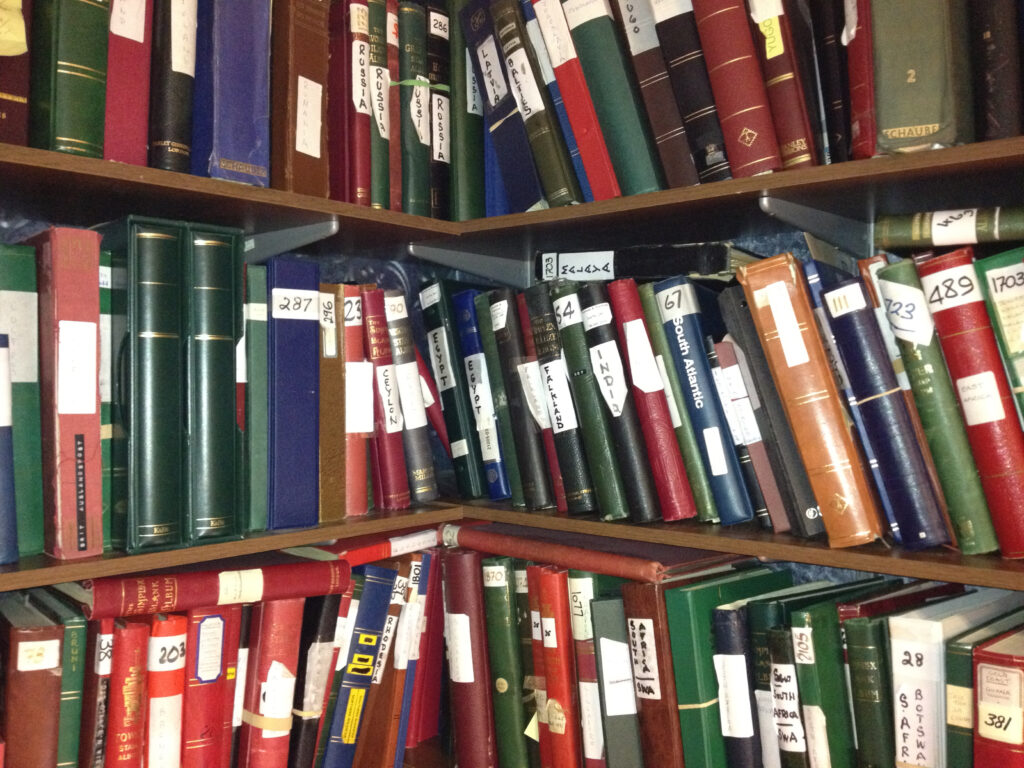Philately is more than collecting. It involves being genuinely interested and where there is interest, there is life. The enthusiasm these “little bits of coloured paper” inspires is far from trivial – when the imagination is engaged, it is art, and when it is shared, it brings people together in a way that transcends differences in age, financial status and social and ethnic backgrounds. In its modest way, philately is part of the glue that holds our world together. – Nicholas Follansbee (A Catalogue of the Stamps of Mexico 1856-1910)
If you are well settled in your collecting habits, know your direction of travel and just enjoy reading the odd blog post, then this section is not for you.
But if you’ve stumbled across this blog, are trying to figure out quite what it all means and have the merest flicker of interest in engaging in the adrenalin-fuelled world of stamp collecting…read on.
Once upon a time, stamp collecting is what your friends did.
In fact, it’s what everyone did. Then it became something your father did and now it’s something your grandfather does.
Except he doesn’t talk about it.
In this cyclical world though, the deeply unfashionable can often become, if not cool, at least a little intriguing. Which is how you ended up here.
How then, do you start collecting stamps?
The road to philately has changed direction
Not so long ago it was easy. You just waited by the front door and waited for the stuff to come through the letterbox. By default you ended up collecting what was available and what was free (which usually meant collecting the stamps of your own country) before acquiring a mish-mash of whatever else came your way.
Before you knew it, you were a worldwide collector. Either you went full tilt into collecting the world, went down the thematic route (cars, cats, cacti etc) or started to narrow your collecting interests down to just one region, era, reign or country.
Those nostalgic for the old days might have had a strong colonial bias or perhaps you picked a country where a relative lived and had ready access to a supply of new material. Either way, your circumstances probably had a heavy influence on what you ended up collecting.
Free of these shackles in the 21st century, those external influences now play a negligible role in influencing new collector behaviour.
The world is at your feet. You have to simply choose the area that sounds most appealing.

Collectors who are already invested (both mentally and monetarily) in a country will find no shortage of reasons why ‘their’ collecting speciality is preferable to another.
And I am no different, with an obvious bias towards Latin America.
Why is Latin American philately particularly attractive?
Let me explain why – the fact that collectors of other regions could use very similar justifications for their own preferences is, of course, completely coincidental.
1. Scope.
Latin America offers the opportunity to collect at a relatively straightforward ‘one of each’ level or has plentiful opportunities to ‘go deep’ and specialise in some of the most complex and fascinating areas of philately.
The large number of provisional issues, overprints, surcharges, varieties and errors could keep you busy for a lifetime.
Whether you decide to specialise in one particular country or to focus on the whole region, Latin America provides a huge amount of variety. A basic collection of all twenty countries or in depth specialisation will both prove rewarding.
2. Design.
Visually, Latin American stamps have some stunning designs, many engraved in the classic style and supplied by the foremost printing houses of the day, such as Waterlow, Perkins Bacon and the American Bank Note Company.
Many early stamps such as the Colon issue of Chile and the Uruguay ‘Suns’ are acknowledged design classics.
Some of the early lithographic efforts can be a little crude, of course, but still exude a certain rustic charm.
3. Cost.
When compared to average prices for stamps from North America, Europe or the British Empire, Latin American stamps offer fantastic value.
In proportion to numbers issued, early Latin American stamps are significantly less expensive than their counterparts from other parts of the world, making purchase, collection and completion very rewarding.
This makes it far more realistic for the collector to put together a unique and fascinating collection without breaking the bank…providing you can track down the stamps, of course.
Despite this, as mentioned above, prices can be very reasonable in comparison to stamps issued in similar numbers from other parts of the world.
4. Investment.
Not necessarily the primary motivator for many collectors and impossible to guarantee any rate of growth. However there are many Latin American issues prior to 1940 that were printed in very small quantities, particularly the higher values and many of the overprints.
Look at the the price of stamps from many other countries with similar low print runs and you’ll quickly realise just how comparatively under-priced some South and Central American material actually is.
The major catalogues don’t really reflect this scarcity, providing some good buying opportunities for the savvy collector. Much as we’ve seen significant price rises in Indian and Chinese stamps over the past decade, Latin America is overdue a correction, particularly as many of these countries continue to develop an affluent middle class with an interest in tangible assets.
So there you have it.
Pick a country. Pick two. Hell, go for the full twenty republics.
Dive in and see where it leads, secure in the knowledge that you are deeply unfashionable by rebelling against the stereotypical pastimes of the 21st century.
Or perhaps, in the vanguard of cool.

I have been collecting South American stamps in the past, but stopped, and now interested in starting again. It’s mainly Bolivia. Is anyone in the Bendigo area into Bolivian stamps. I wonder if auctions are the best way to find the missing stamps. It would be good to have someone more experienced look at what I have and give me some pointers.
Hello,
If you are still interested I could give you some advice and share my knowledge on Bolivian stamps.
Dear Marco,
I just started collecting Bolivia, but perhaps to make it a bit more interesting, i collect the proofs, essays, color trials and the “unusual ” materials.
I’d love to share knowledge Thanks
Hi,
I am a collector from Italy. So far, I’ve been collecting mainly Italy, classic Spain and USA.
I am fascinated by Latin American stamps and I found out this wonderful and very informative website.
I have a question about starting a new collection in this area (mostly classic period, not really modern issues). According to your experience and point of view, what country from Latin America would you suggest to start with for a newbie collector? (I am purposedly excluding a continent-wide collection for the moment).
What are the pros and cons of building a collection of that specific country?
Thanks in advance and happy collecting to everyone,
Gianluca
That’s a very good question. But a question that could be answered in so many ways.
You have a choice of twenty countries. So I would start by looking through a general, all world catalogue to get a feel for the stamps of each country. Are there particular countries that stand out as more interesting than others; are there countries that don’t appeal and could be rejected quickly? This will, at least, build a shortlist.
Do you prefer to collect mint or used? If used, a country that has a strong collector base of town cancels, such as early Peru, may appeal. Or the district overprints of Mexico.
What about design? If you gravitate towards quality engraved stamps then countries that relied heavily on international printers such as ABNC might appeal (for example Haiti, Costa Rica or Nicaragua).
If you are looking for a ‘compact’ country to collect then a country such as Chile has just over 200 regular issues before 1940 and only 50 or so airmails. Colombia, in comparison, has nearly 500 regular issues and 120 airmails…and that’s before you start to factor in the Colombian States and the SCADTA issues which will increase your collecting range considerably.
For complexity, you probably can’t beat Nicaragua. Its profusion of provisional overprints and varieties could keep you busy for a lifetime.
And then there is the subject of cost. Although all Latin America is comparatively inexpensive compared to the US, Europe and British Empire, there are certainly areas that would need deeper pockets in the early issues. The more expensive countries are Argentina, Brazil and Mexico, probably followed by Colombia, Venezuela, Uruguay and Peru.
At the other end of the spectrum, collections of countries such as Haiti, Honduras and Paraguay can be put together very economically…and still provide hours of opportunity for research and hunting out varieties.
Lots to consider! If you have any specific questions, drop me a mail (see Contact menu) and I will endeavour to help further.
Dear Nick,
thank you so much for your great explanation of the different ways to start thinking about collecting Latin America. I have the Scott classic catalogue, so I can definitely start there. Your other suggestions are incredibly useful, thanks!
If other collectors are willing to share their opinion of experience with this, I will greatly appreciate 🙂
The other thing I need to consider is the availability of material in Europe, especially from less “popular” countries, right?
I am very happy that I found this great website, which is a very good source of information! I will probably bother you again with other questions, if I may 🙂
All the best,
Gianluca
I collect most of the republics but if I had to recommend one it would be Uruguay. The reasons are:
Not too many overprints or surcharges.
Some lovely Waterlow designs. Can there be a more beautiful stamp than the 5 centesimos of 1900?
The classic “sun” issues are very attractive and can be plated. The town cancels are a nice area of study, there are only about 40 of them.
The large numeral issue of 1866 must be the most incompetently professional printing job ever and can be plated (see my guide on ebay) and hence an opportunity for some cheap in depth philately
The albatross and pegasus airmail issues are great designs.
The major drawback is the high price of the first issue.
Uruguay is certainly perennially popular, not least for some of the reasons you outline above.
“Can there be a more beautiful stamp than the 5 centesimos of 1900?” Well, that’s up for debate! There’s certainly a few contenders out there…but the 5c is a beauty.